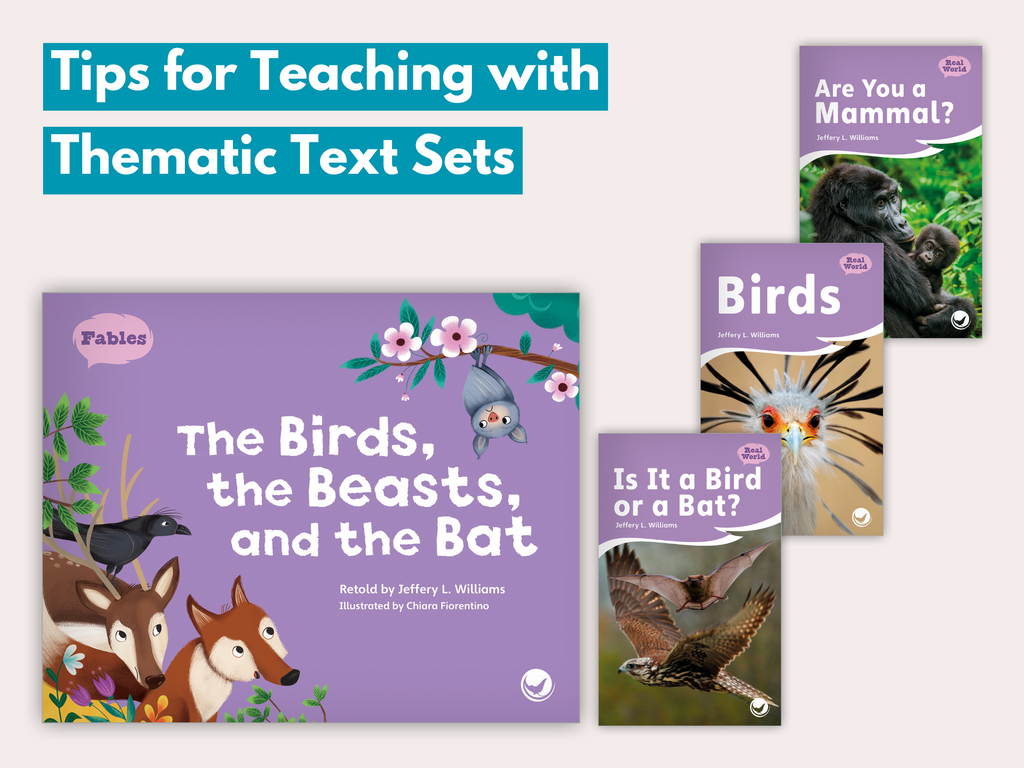By Beth Richards
Thematic text sets can be a great way to build background knowledge, practice comprehension skills, boost vocabulary, and introduce and compare multiple text structures. Try these tips and scaffolds to help you get the most out of thematic text sets.
Which Book First?
Consider your students’ background knowledge to help you determine which book and genre to use first. For example, the text set with the fable, The Birds, the Beasts, and the Bat, includes three related nonfiction books. Knowing your students’ understanding of the concept(s) will help you determine if you read the fable and then dig into the informational texts or if the students need to work through the informational books first to prepare them for understanding and discussing the fable.
Maintain A Connection Between Books
Maintaining a conversation about the information learned throughout a thematic text set deepens comprehension. Remember to keep all the books from the text set available so you can refer to them at opportune learning moments.
A great way to make text-to-text connections with students is to create reference sheets and write down important concepts and vocabulary words as you work through the texts. Encourage students to refer to the reference sheets and add more information as they read. This can serve as a jumping-off point to compare and contrast information from the books. It can also be used after reading the text set for comprehension projects where students write or present what they learned.
For example, with the thematic text set above, have students begin by reading the informational texts Birds and Are You a Mammal? Gather information on the reference sheets and encourage conversations about the differences between birds and mammals. There is also a great vocabulary word, attributes, in the book Are You a Mammal? Now that students have built their background knowledge, they can apply this to the fable. In the fable, birds and beasts argue about which is the better animal group. There are a few pages where the animals discuss their attributes and how those make them unique. Ask students to find those pages (the word attribute is not used, so they will have to apply knowledge of the meaning of that word). Next, compare how the attributes are explained in the fable versus the nonfiction texts. You can also discuss why the mammals in the fable are called beasts.
Finally, you can challenge students to think about the bat in the fable. The bat cannot decide whether to be on the same team as the beasts or the birds. Ask students to form an opinion about why the author used a bat for this character (instead of a snake or spider). Students can use their reference sheets from the nonfiction books to provide evidence from the text to support their opinions.
Compare Genres by Discussing How Books Are Organized
A great way to compare genres is by looking at how the books are organized. Fiction and nonfiction are set up differently. While fiction uses illustrations and often tells a sequence of events, nonfiction uses facts, diagrams, glossaries, and photographs with captions to support meaning.
Nonfiction books can also vary in the way the information is presented. For example, some informational books are set up in a question-and-answer format, while others compare and contrast. Finally, many informational books on animals use similar formats, with sections on description, food, habitat, life cycle, etc. Children need to recognize these structures to help scaffold their learning.
You can use a text such as Is it a Bird or a Bat? to teach students how the book is organized. On the left page, the author teaches about birds, and on the right page, the author talks about bats and how they are similar or different from birds. Practice note-taking from a text; use a graphic organizer, such as a Venn diagram, to scaffold students through the text and information presented.
Provide students with books that are organized similarly. Here are a few examples: Tigers and Lions: Alike and Different, Is it a Donkey or a Horse?, and Turtle or Tortoise? Encourage students to use the same tools to navigate these types of texts. Students can become “experts” and share their learning with their classmates through writing or speaking.
Thematic text sets are powerful tools with endless opportunities for learning and practicing essential comprehension skills. They encourage students to think beyond the book, making text-to-text connections. Also, text sets are fun! They motivate students because they provide a learning purpose for reading.
~~~
This blog features book examples from Fables & the Real World, a unique series of thematic text sets featuring one fable paired with three related nonfiction texts. Fables are beautifully illustrated and relay a social-emotional message at the end of each story. Related nonfiction supports building background knowledge, boosting vocabulary, and genre comparison. These thematic text sets cover a variety of topics taught in the classroom. They are ideal for young readers in grades 1–2.
~~~































































![6 Fun and Easy Activities to Practice Sequencing [Grades K-1]](http://www.hameraypublishing.com/cdn/shop/articles/Red_Typographic_Announcement_Twitter_Post-5_bf1ae163-a998-4503-aa03-555b038d1b76_600x.png?v=1689961568)
![Leveraging Prior Knowledge Before Writing and Reading Practice [Grades 1–2]](http://www.hameraypublishing.com/cdn/shop/articles/Red_Typographic_Announcement_Twitter_Post-4_600x.png?v=1689961965)




